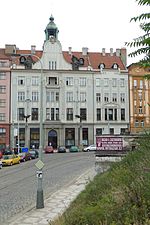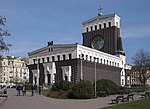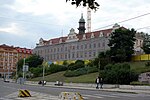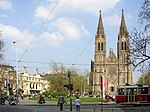Hus Congregational House
Churches in Prague 10Hussites

The Hus Congregational House, or Husův sbor, is a Hussite church in Dykova Street in Prague 10. It was completed in 1935 as part of a multi-functional development by architect Pavel Janák in the constructivist style. The tall, six-storey minimalist tower and belfry carries a 700 kg copper chalice as a symbol of the Hussite Church. The tower was briefly used to create an alternative radio station during the Prague uprising in 1945.
Excerpt from the Wikipedia article Hus Congregational House (License: CC BY-SA 3.0, Authors, Images).Hus Congregational House
U Vodárny, Prague Vinohrady
Geographical coordinates (GPS) Address Website External links Nearby Places Show on map
Geographical coordinates (GPS)
| Latitude | Longitude |
|---|---|
| N 50.074343 ° | E 14.4489 ° |
Address
Husův sbor Vinohrady
U Vodárny
120 09 Prague, Vinohrady
Prague, Czechia
Open on Google Maps










